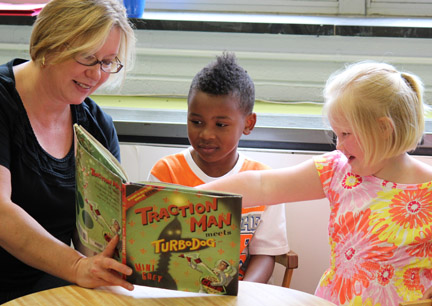According to findings published today in the journal Science, publicly funded pre-kindergarten classrooms that received the highest marks in quality rating systems used by the majority of states are no better at fostering children’s school readiness than classrooms with lower ratings.
However, researchers at the University of Virginia, Northwestern University and the University of North Carolina, Chapel Hill isolated one factor of the many used in the rating systems that did make a difference in school readiness: the quality of teacher-student interactions.
Even before President Obama promised to work with states to “make high-quality preschool available to every child in America” during his January 2013 State of the Union Address, national debate was taking place to accurately define “high-quality preschool.”
“A primary purpose of preschool is to advance children’s learning and development in preparation for kindergarten; this is especially true for disadvantaged children who are mostly served by publicly funded programs,” said Robert Pianta, dean of the Curry School of Education at the University of Virginia and founding director of U.Va.’s Center for Advanced Study of Teaching and Learning. “Yet these findings demonstrate that current program quality evaluation models don’t predict the very thing that public pre-K programs are being designed and funded to produce.”
The paper, “Can Policy-Relevant Ratings of Pre-K Programs Predict Children’s Learning?” is co-written by Pianta; Terri J. Sabol, postdoctoral fellow at the Institute for Policy Research at Northwestern; Sandra L. Soliday Hong, postdoctoral fellow at the University of North Carolina; and Margaret R. Burchinal, senior scientist at the University of North Carolina.
These researchers used data from two studies of nearly 3,000 children in 703 state-funded pre-kindergarten classrooms from nine states, representing a variety of pre-kindergarten models in use across the United States. Using this data set, investigators calculated the extent to which various features of program quality included in each of nine different states’ Quality Rating and Improvement Systems, or QRIS, actually predicted children’s readiness for kindergarten at the end of their year in pre-K.
A Quality Rating and Improvement System is a method for collecting and compiling information on program features presumed to measure program quality. Higher ratings should equal higher quality. To the extent that enrollment in high-quality pre-K programs is a means of fostering children’s success in school, then children attending higher-rated programs should perform better on measures of kindergarten readiness. To determine readiness, children’s learning and development were evaluated by assessing gains in academic skills, language skills, social skills and problem behaviors in the pre-kindergarten year.
The researchers selected the five most commonly used measures of quality used in multiple states’ QRIS: staff qualifications, physical environment, class size, teacher-child ratio and qualities of interactions between teachers and children. They combined these indicators to calculate overall quality ratings using formulas from the QRIS systems used in nine states.
Results demonstrated that whether a child was enrolled in a highly rated program was unrelated to their gains in learning during pre-K or their readiness to begin kindergarten.
While the aggregate ratings, with many measures, didn’t predict children’s learning, the researchers were able to pinpoint a single measure that would identify quality pre-K classrooms and consequently, which students would learn more.
“Children who were in classrooms with higher ratings based on observed interactions between teachers and students were more prepared for kindergarten,” Sabol said.
This study suggests that states ought to make changes in the ways they rate the quality of pre-K programs. Rating systems should focus on rating the quality of teacher-child interaction in order to assess and improve the components that matter most for children’s learning, Sabol said.
“Quality pre-K education can make a real difference for children,” Pianta said. “Yet when we measure program quality, we must focus on the features that actually make that difference for children. The major policy models being used for evaluation relate neither to children’s learning gains in the pre-K year nor to school readiness. Of all the features of preschool programs that can be measured, observations of teacher-child interactions may be most valuable.”
Media Contact
Article Information
August 22, 2013
/content/study-states-methods-rating-preschool-quality-fail-predict-children-s-readiness-kindergarten

